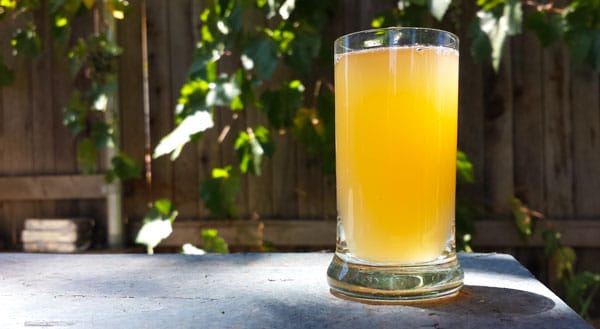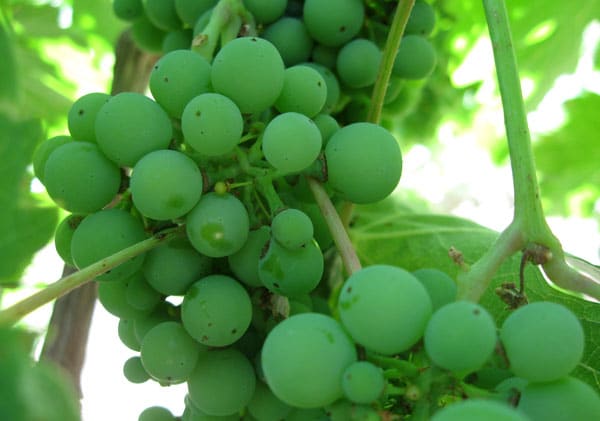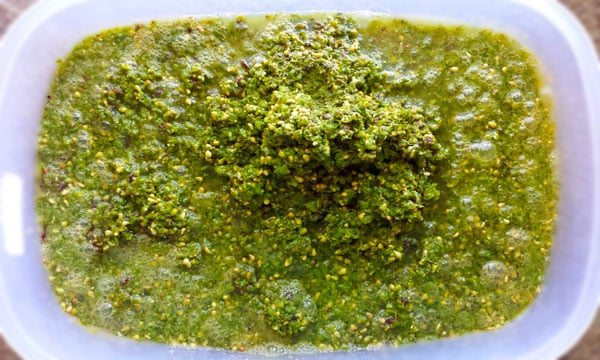As an Amazon Associate I earn from qualifying purchases.

You know the old saying, “When life gives you lemons, make lemonade?” Well, when life gives you unripe grapes, make verjus. Sometimes I am not around in autumn to harvest the grapes in my yard. Sometimes I want a finer crop for wine, so I thin the fruit from my little vineyard of 11 plants. Lest you think I could just gorge myself on grapes if I didn’t want to make wine, keep in mind that wine grapes are small, with lots of seeds — so they’re not the best for eating off the vine. What’s more, I hate the idea of wasting, so I make verjus.
Verjus, pronounced vehr-ZHOO, is a sort of vinegar made from the juice of unripe grapes. (It can also be spelled “verjuice”) The grapes you see in the picture are not green grapes, they are Zinfandel grapes, which will turn a lovely burgundy in a month or so. You can make verjus with any unripe grapes, even wild ones. You want to pick them the moment a few start to turn color.

As you may have surmised by the name, verjus is a French creation. Traditionally it is made with the thinnings of a vineyard’s crop — the French thin their crop dramatically for reasons having to do with both the quality of the wine and because grapes can struggle to ripen in their comparatively cold climate. Many good California vineyards drop fruit in July to make the vines focus their energy on the remaining clusters. This makes better wine down the road.
Verjus itself is really nothing more than sour, acidic grape juice. But what it does is give a recipe acidity without the hammer of a true vinegar. A dish acidified with verjus will remain wine-friendly — if you’ve ever eaten vinegar pickles while drinking wine you will know that this is not a good combination…
So how do you make verjus? You will need unripe grapes. Lots of them. Anything you do with grapes requires many pounds for what seems like a small amount of juice. In winemaking, the ratio is typically 12 pounds of grapes to 1 gallon of wine. My verjus ratio was more like 12 pounds of grapes for about 2 to 3 quarts of verjus. So yeah, you need a bucket of grapes to make this.
Fortunately, green grapes grow near you. Most every place in America has wild grapes, usually along riversides. Go find some and fill a five-gallon bucket full. Or thin your personal vineyard…

[recipe_name]How to Make Verjus[/recipe_name]
[summary]You will need lots of grapes, a meat grinder or food mill, a fine mesh strainer, paper towels, a ladle, some Mason jars and some patience. And, if you want your verjus to hold up for a long time in the fridge, you will need a little citric acid. If you really want it to hold up for 6 months or more, add the winemaker’s friend: sodium metabisulfite, which is available at any winemaking shop. This is the “sulfites” you see on wine labels. If you are sensitive to them, skip it.[/summary]
[yield]Makes about 2 to 3 quarts.[/yield]
Prep Time: [preptime time=90M] 90 minutes [/preptime]
Cook Time: n/a
- 10 pounds unripe grapes
- 1 teaspoon citric acid
- 1/2 teaspoon sodium metabisulfite
[instructions]
Take most of the stems off the grapes. This will take some time, maybe an hour or so. Longer if you’ve never done it before. But if you don’t do this part, you will have a tough time running the grapes through the food mill.
Grind the grapes through a coarse die on your meat grinder. Sadly, the Kitchenaid attachment isn’t strong enough for this task, so you need a real grinder. I use the Weston 1/2 horsepower grinder, and I can highly recommend it. I use a 7 mm die — large enough to let the seeds get through (you don’t want to crush them) and small enough to grind even small grapes. If you have the meat grinder, this process takes only a couple minutes.
If you don’t, you can use a food mill fitted with a coarse plate. This is a distant second and will require a little elbow grease.
As you get a slurry of ground-up grapes and grape juice, pour it into a bowl as you work. You will need to work quickly, as the grape juice will oxidize quickly and turn brown. There is really no getting over this, but the faster you work the greener — or at least more golden — your verjus will be. Work slow and it will look like malt vinegar.

Now you need to run the ground grapes through a fine mesh sieve. If you have rubber gloves, put them on. Why? The acid in these grapes made my hands sting for a couple hours after I squeezed the ground-up grapes over the sieve. And yes, you need to squeeze your grapes because you really want as much liquid as you can extract.
You can take an optional step of straining the juice a second time through the strainer with a paper towel set inside. This will remove a lot of the extremely fine particulate matter floating in your verjus. As you pour, it will catch in the paper towel, eventually stopping the flow of the verjus. You will need to replace the paper towels a couple times.
Finally, you will need to pour the strained juice into a Mason jar. It’s at this point that you add the citric acid and sodium metabisulfite, if you are using them. Shake the jar well to mix everything in, then put it in the refrigerator for up to 2 days. There will be a very fine layer of sediment on the bottom, even if you did the paper towel trick. You will not be able to strain this off — it is too fine.
So, what you need to do is gently decant it into a clean container. You will lose some verjus, but that’s OK. If you don’t do this step your verjus will oxidize even more. Nothing bad will happen, but it will look ugly.
Bottle and store in the fridge. It should last for several months in the refrigerator, and up to 9 months if you use the citric acid and sodium metabisulfite. You can also freeze it.
How to use your verjus? It is an awesome salad dressing — I’ve dressed a green salad with verjus and melted wild duck fat many times — and it is a great thing to use wherever you want a gentle acidity.
MORE ON VERJUS
- My recipe for Pheasant Legs with Verjus and Mushrooms
- An ancient method of making verjus, with brandy and vinegar, in 18th Century Cuisine
- More recipes for vinegars and preserved foods




Thanks for the recipe! We are getting ready to prune our second year grape vines, and I thought there must be a use for all these gorgeous unripe grapes. I’ll be putting my kitchen aid grinder to use shortly!
So glad you posted this- such a lifesaver! I have my whole pergola covered in grapes, but I won’t be around for when they ripen. I was hoping there was something I could do with the unripe grapes, and fortunately I have enough time to make this.
All my grapes have pretty much turned purple so given I don’t want to make wine, any other ideas?
CAN someone tell me if verjuice can be bottled the same way as wine for the purpose of storing in a cellar or pantry instead of a refrigerator. Dose it have to be sterilized beforehand or fermented before? Does sterilization or fermentation affect its palatability or its use in the kitchen. I’ve searched the net and various other sources without results. Thank You!
I recently fell upon a bottle of VERJUS in the refrigerator of a friend. It’s expiration is 2007……..how long can this be kepted?
Thank you.
Sincerely,
Anne
Hi,
nice instructions for Verjus. I always make some to make my own Dijon mustard. Verjus is used instead of vinegar.
Regards
Karl
I’ve made verjuice for 3 years in Chile, my wife being Persian is used to using it (“ab-ghooreh”). I was hooked when we were eating Argentine goat & she smashed unripe grapes with her fork on the plate to accompany. She “processes it in the sun in sealed bottles for days – which I don’t do – & uses seedless grapes to avoid seed bitterness.
It’s reputedly good for cholesterol & more. I like it best to deglaze the pan after browning meat, or where I’d use vinegar or lemon (e.g. salads), and swallow a little as “chaser” after a meat meal.
I’m just sorry per recipes it has a short storage life, maybe 3 months.
Rita: Sorry, I have no idea.
Hi thanks for the information on Verjus, I really learnt a lot today would just love know how would I be able to bottle the Verjus if I would like to sell it to the public? Thanks once again humbly gratefully
I have grapes growing all around my house. Usually I boil the juice for a short while to stop any unwanted fermentation. I’ll try your method this year….. I’m just off to pick.
I planted some grapes last year. If I get fruit this year I definitely want to make this. Thank you for this post.
Could you strain the verjus through a coffee filter or an old maple syrup filter to remove the sediment so you can lose even less? or is it too acidic? I realize the amount lost is negligible but its just something I thought of while reading this.
How interesting. I had never hear of verjus. I’ll have to invest in a food mill and see if my in-laws have an overabundance of grapes again this year. I haven’t ever noticed wild grapes in Sweden, but I’ll keep my eye out for those too.
Sold, I’m going to make a haul of green grapes the next time I’m in a canyon.
I love verjus. It really is the missing link of vinegars. Although I have yet to try the English crabapple version I have made a few with grapes. You have really inspired me with the idea of using wild grapes. They are pretty nasty on their own.. fabulous to find a use for them.. thanks Hank!!
Wow – I learned something new, and possibly even useful. Now I have to go on a hunt for unripe grapes.